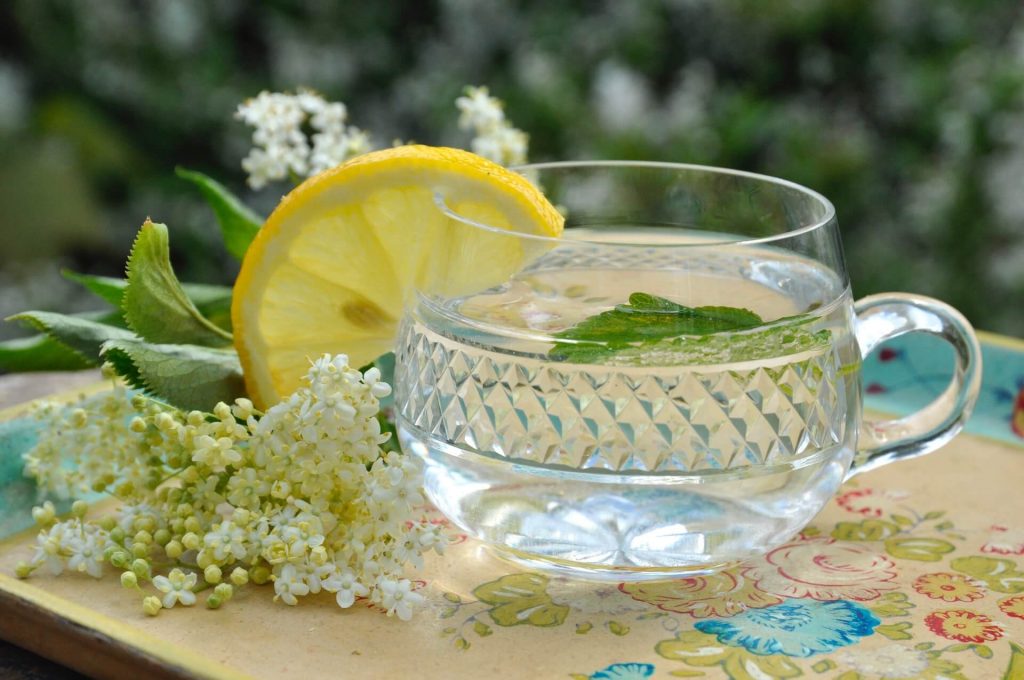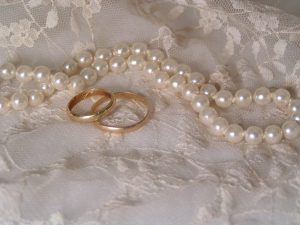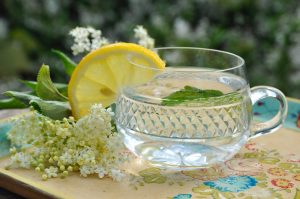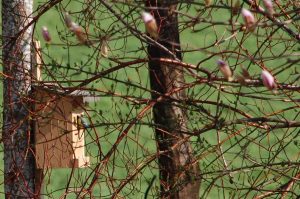Recipe: Elderflower – Vinegar Syrup
20 years ago, I was travelling to Switzerland with a couple of friends. When we had arrived at the home of our friends, dinner had been set and a couple pitchers of what appeared to be water were sitting on the table.
I was really thirsty and poured myself a large glass of crystal clear water. Suddenly, my best friend stopped me.
“Kristin. That’s not water!”
Thinking it must be poisonous, I tentatively nipped at the glass.
Why the heck had my friend stopped me? This was DELICIOUS! It tasted vaguely of honey, but lighter. The tiniest thought of lemon brightened the flavor.
Elderflower nectar: it has been a favorite drink of mine for years.
Elderflower nectar is typically made using a floral syrup.
Just those words alone can turn people off to trying it. I admit myself to being suspicious of floral recipes. You will not find me seasoning my salads with violets and lavender (although I have tried it). Dandelion is not something I forage for.
But Elderflower is different.
First, it is made of the opened flowers as young as can be gathered. The primary flavoring element is the pollen from the flower. Secondly, it cannot be dried and stored. As an open flower, drying it loses the pollen and makes it tasteless. Thirdly, elderberries are the autumn pendant to the flowers and that makes the floral syrup is the only way to effectively capture the flavor for juices while leaving enough to become berries.
This year, my neighbor offered to go “Hollerbrechen” with me. That is harvesting the holunder, or Elderflower, by breaking off the flower pads. She even cleaned out a bucket for me and gave me a new recipe to try.
Because it was a new recipe, I decided to make a simple recipe. As it is proportional, it is very easy to make as much or as little as you want.
Utensils:
- Bucket with lid
- Scissors
- Stovetop
- Large pot
- Spatula or stirring spoon
- Measuring cups
- Lint-free towel
- Coffee filter or double cheesecloth for straining
- SieveFunnel
- Bottles (small) for storage
Ingredients:
- 10 pads elderflower
- 2 kg sugar
- ½ liter fresh lemon juice
- ½ liter white wine vinegar
A couple of points to take into consideration.
Firstly, the number of pads is not precise. If your pads are smaller, you may want to pick more. If they are large, 10 seems to be the magic number.
At the same time, the amount of sugar is also not of vital importance. I did not have 2 kg of sugar in the house, so I used just over 1.5 kg and added a bit of raw honey to the end of the recipe and it turned out great.
The lemon is also an approximate amount. I used the juice of 6 lemons and was short, but then I added ½ of the juiced lemon into the syrup mixture and Thomas thinks it is almost too lemony.
Make sure you are using a wine vinegar and not distilled vinegar. This recipe needs a very mild vinegar. As my neighbor said: use the cheap stuff, you won’t taste a difference.
Step 1: Hollerbrechen—gathering the elderflowers
When breaking elderflower, the trick is to break it smoothly and NOT shake it to remove the bugs. You want as much of the pollen as possible. If the flowers are nearing the end of the season, you may want to gather a bit more.
DO NOT, I repeat, DO NOT shake the flowers to “get the dust off”, “bless Mother Earth”, or “get rid of insects”. What this does is shake off all that lovely pollen–and that is the good stuff. The pollen is where the sweetness and flavor lies, not the petals and certainly not the stems.
I think I gathered 15 pads.
After you break it, place it upside down in the bucket. The stems should point up. This encourages any bugs to climb out of the flowers and up the stems and bucket sides.
Step 2: Prepare the elderflower
You will not wash the flowers. Technically, you don’t have to do anything special, but I chose to remove the large stems leaving the pads connected together. The fewer the stems, the less bitter the syrup will be and the more compact the floral addition will be.
I also wiped down the bucket sides and lid before filling it with the syrup. This removed dust and most of the bugs (there weren’t many at all—most flew away).
The syrup will be heated and filtered, so don’t worry about “eating insects”.
Step 3: Prepare the syrup
The syrup is basically a simple syrup made using the lemon juice and vinegar instead of water.
Press the lemons until you have the recommended amount of liquid. Save up to 1 sliced lemon for adding to the syrup-elderflower mix.
Add the lemon juice and vinegar to the pot and heat it on mid heat. Do NOT boil.
Add the sugar stirring until it is completely dissolved.
This took me about 5 minutes.
Step 4: Add syrup to the elderflowers
If you choose to, add the lemon slices to the elderflowers.
Gently pour the hot syrup into the flower bucket. Use the spoon or spatula to scrape the sides.
It is not necessary to stir the flowers.
Step 5: Wait
Patience is a virtue.
Yes. This recipe takes 10 days to steep. The good news is that it does not need any special care or coddling. You do not have to sing it lullabies or read it sonnets by the moonlight.
Put the covered bucket into a corner and “forget it”.
Step 6: Filter and decant
Make sure that your bottles are clean and sterile. You are not required to can it, as it will be preserved by the sugar and vinegar for up to 1 year. However, it is always better to have sterile bottles and caps when filling. The sugar mixture can grow mold if it is present.
Line a sieve with the cheesecloth or prepare the coffee filter. Place it over a pot. You don’t want to filter into the bottles.
Pour the mixture through the filter at least once. If particles get through the cloth, you might want to refilter.
I filtered the mixture twice, wringing out the flowers as tightly as I could to get as much syrup out as possible.
I chose to heat up the mixture and pour it into hot bottles. This semi-bottles it.
Pour the heated syrup into the clean bottles and close with sterile caps.
I ended up with about 1 ¾ liters of syrup. This should be enough for the summer, as we drink other things, as well.
To Use:
Using the syrup is much like coffee syrups. Only a very little is needed.
When I had filled all the bottles, I added a liter of fresh cold water to the pot, swirled it around to mix the syrup into it and then filled a pitcher. After tasting it, I added about a tablespoon of syrup to the water. That is all.
When Thomas makes a glass, he adds 1 to 1 ½ teaspoons of syrup to the glass. I add a bit more–but I like things on the sweeter side.
- 1-2 Tablespoons syrup for 1 liter water
- 1 to 2 teaspoons syrup for 1 glass (350 ml) water
The syrup may also be used in baking in place of simple syrup to add flavor. Thomas’ mom used it when making a cake and I know people who have used it to flavor buttercream frosting, instead of sugar.
This syrup can also be used to add flavor to other cold drinks–I used it for part of the sugar in homemade lemonade. THAT was amazing! I have also added it to seltzer water for a refreshing “soda”.
One of our (admittedly purchased) summer drinks has been elderflower-apple seltzer. I am working on recreating it, but the proportions just aren’t quite working, yet.
Elderflower syrup can also be used in alcoholic drinks added to prosecco and white wine coolers.








